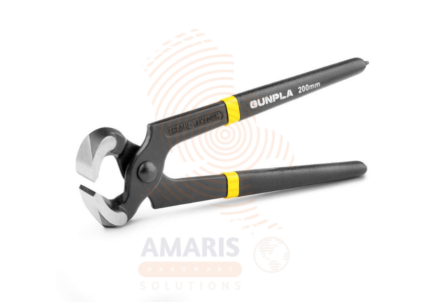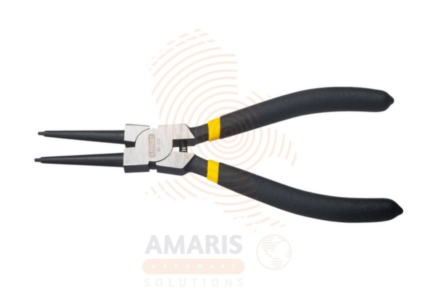Tile Cutter
WhatsApp Order
A tile cutter is a manual or powered tool specifically designed for cutting ceramic, porcelain, or other types of tiles. It typically consists of a sharp cutting wheel or blade that is guided along a straight edge to score the tile’s surface. After scoring, the tile is then snapped or separated along the scored line, resulting in a clean and precise cut. Tile cutters are widely used in construction, home improvement, and tiling projects to achieve accurate and customized tile sizes for various installations.
Description
Uses of a Tile cutter
- Floor and Wall Tiling: Tile cutters are essential for cutting tiles to fit specific areas during floor and wall tiling installations. They allow for precise cuts to accommodate corners, edges, and obstacles.
- Bathroom and Kitchen Remodeling: During bathroom and kitchen renovations, tile cutters are used to trim tiles for spaces around sinks, faucets, outlets, and appliances, ensuring a neat and professional finish.
- Backsplash Installations: When installing tile backsplashes in kitchens or bathrooms, tile cutters are employed to cut tiles to the required size and shape, especially for intricate patterns or designs.
- Outdoor Tile Projects: For outdoor projects such as patios, walkways, or pool areas, tile cutters are used to customize tiles to fit the designated spaces and create a visually appealing and functional surface.
- DIY Home Projects: Tile cutters are popular among do-it-yourself enthusiasts for various home projects. They can be used for creating custom tile designs for tabletops, decorative accents, or other creative applications.
- Repair Work: In cases of tile damage or replacement, tile cutters are used to trim replacement tiles to match existing ones seamlessly.
- Commercial Installations: Tile cutters are extensively used in commercial settings such as offices, restaurants, and retail spaces for tiling floors, walls, and other surfaces with precision and efficiency.
- Craft and Art Projects: Tile cutters are employed in crafting and art projects that involve tiles, mosaics, or other tile-related materials. Artists use them to achieve specific shapes and sizes for their creations.
- Custom Tile Designs: Tile cutters enable the creation of custom tile designs, allowing for unique patterns and layouts that can enhance the aesthetic appeal of a space.
- Ceramic and Porcelain Tiles: Tile cutters are specifically designed for cutting ceramic and porcelain tiles, which are commonly used in residential and commercial spaces due to their durability and aesthetic versatility.
SAFETY HANDLING PRECAUTIONS
- Wear Personal Protective Equipment (PPE):
- Safety glasses or goggles: Protect your eyes from flying debris, especially when cutting tiles.
- Dust mask: Prevent inhalation of dust particles generated during the cutting process.
- Gloves: Wear gloves to protect your hands from sharp edges and potential cuts.
- Work in a Well-Ventilated Area:
- Ensure proper ventilation to minimize the inhalation of dust and fumes. Consider using a dust extraction system if available.
- Read and Understand the User Manual:
- Familiarize yourself with the manufacturer's instructions and guidelines provided in the user manual. Follow the recommended procedures for setup, operation, and maintenance.
- Inspect the Tile Cutter:
- Before use, check the condition of the tile cutter, including the cutting wheel or blade, to ensure it is in good working order. Replace any damaged or worn parts.
- Secure the Tile Cutter:
- Place the tile cutter on a stable and level surface. Ensure it is properly secured or clamped to prevent movement during operation.
- Mark the Cutting Line:
- Use a pencil or marker to mark the cutting line on the tile. This helps guide the cutter, reducing the chances of mistakes and ensuring precision.
- Use Proper Technique:
- Follow the correct cutting technique recommended by the manufacturer. Apply even pressure while scoring the tile, and use a smooth, controlled motion.
- Protective Shield:
- Some tile cutters come with a protective shield or guard. Make sure it is in place to contain any potential debris and enhance safety.
- Mind Your Hands:
- Keep your hands away from the cutting path, especially when operating the tile cutter. Use a handle or other gripping devices provided by the tool.
- Dispose of Waste Safely:
- Dispose of tile remnants and waste in a safe manner. Do not leave sharp tile pieces lying around, as they can pose a hazard.
- Switch Off When Not in Use:
- Turn off the tile cutter when not in use, and unplug it if it's an electric-powered tool. This prevents accidental starts and ensures safety during maintenance.
- Keep a First Aid Kit Handy:
- Have a first aid kit nearby in case of minor cuts or injuries. Know the location of the nearest emergency exit or medical assistance, especially in a workshop setting.
Related products
Ball Point Hex Wrench Set – Medium
A Ball Point Hex Wrench Set - Medium size typically refers to a collection of nine hexagonal (hex) wrenches designed with ballpoint ends. The term "medium" may refer to the size or thickness of the wrenches, indicating that they are neither too small nor too large. The ballpoint end allows for a more flexible angle of approach when using the wrench, making it easier to engage with hexagonal screws or bolts at various angles. This set is likely to include different sizes to accommodate a range of applications, providing versatility for tasks that require hexagonal tools of medium dimensions.
Ball Point Hex Wrench Set – Short
A Ball Point Hex Wrench Set - Short refers to a collection of nine hexagonal (hex) wrenches, commonly known as Allen wrenches, designed with a ballpoint tip for easy access and angled entry into hexagonal socket screws. The term "short" indicates that these wrenches have shorter shafts compared to standard-sized wrenches. This set is likely to be compact and versatile, suitable for various applications where hex screws of different sizes need to be tightened or loosened efficiently. The ballpoint tips allow for a degree of flexibility in the angle of approach, making them particularly useful in situations where direct access may be challenging.
Bi-Metal Hole Saw Set
A 9 PCS Bi-Metal Hole Saw Set refers to a collection of nine hole saws, each constructed with a bi-metal design. A hole saw is a cylindrical cutting tool used to create holes in various materials such as wood, metal, plastic, and more. The term "bi-metal" indicates that the hole saws are made from two different types of metals, typically high-speed steel (HSS) and a more durable alloy like cobalt. This combination enhances the hole saw's cutting performance, making it suitable for a wide range of applications and providing increased durability and longevity. The set typically includes hole saws of different sizes to accommodate various hole diameters, making it a versatile tool for professionals and DIY enthusiasts alike.
Carpenter’s Pincers
Carpenter's pincers, also known as end-cutting pliers or end nippers, are a type of hand tool used in carpentry and woodworking. They typically have sharp, pointed jaws that come together in a cutting edge at the tips. These pincers are designed for gripping, cutting, and pulling materials such as nails, wires, or small objects in woodworking applications. The jaws are angled to provide leverage and facilitate precise cutting or gripping in tight spaces. Carpenter's pincers are a versatile tool commonly found in a carpenter's toolkit for various tasks related to shaping and assembling wood.
Electrician Screwdriver Set
An electrician screwdriver set typically refers to a collection of six individual screwdrivers specifically designed for use by electricians. These screwdriver sets often include a variety of sizes and types of screwdrivers that are commonly used in electrical work. The set may include Phillips and slotted screwdrivers in different sizes, as well as insulated handles to provide electrical safety when working on live circuits. The goal of such a set is to provide electricians with a versatile and comprehensive tool kit to tackle various tasks in the field of electrical work.
External Circlip Pliers Straight
External circlip pliers – straight, also known simply as external circlip pliers or snap ring pliers, are specialized hand tools designed for installing and removing external circlips or snap rings. Circlips are ring-shaped fasteners with open ends that fit into machined grooves on the outside of a shaft or bore. External circlip pliers are specifically designed to work with these types of retaining rings.
The "straight" designation indicates that the tips of the pliers are aligned in a straight line, as opposed to angled or curved tips. This straight configuration allows for easier access to circlips in certain applications.
These pliers typically have pointed or semi-circular jaws that fit into the holes or notches of the circlip, facilitating the compression or expansion of the ring for installation or removal. The handles are designed for comfortable grip and effective leverage.
Flat Steel File
PRODUCT DESCRIPTION
A flat steel file is a hand tool used for shaping, smoothing, and removing material from a workpiece, typically made of steel. It consists of a flat, elongated piece of metal with a series of parallel teeth or ridges along one or both of its surfaces. These teeth are designed to cut or abrade material when the file is pushed or pulled across a surface. Flat steel files are commonly used in metalworking, woodworking, and other crafts to achieve precise and smooth finishes on various materials.
Flat Wood File
PRODUCT DESCRIPTION
A flat wood file is a hand tool used for shaping, smoothing, and refining the surfaces of wood. It typically consists of a flat, narrow, rectangular piece of metal with a series of parallel, coarse teeth or ridges along one or both of its sides. These teeth are designed to efficiently remove material when drawn across the wood grain, allowing for the leveling and smoothing of wooden surfaces. Flat wood files are commonly used in woodworking and carpentry for tasks such as shaping edges, refining contours, and removing rough spots on wood surfaces.


 Acrylic Sealants
Acrylic Sealants Construction Adhesives
Construction Adhesives Double-Sided Tape
Double-Sided Tape Duct Tape
Duct Tape Electrical Tape
Electrical Tape Epoxy & Resins
Epoxy & Resins Masking Tape
Masking Tape
 Automotive Wrenches & Socket Sets
Automotive Wrenches & Socket Sets Battery Chargers & Jump Starters
Battery Chargers & Jump Starters Car Jacks & Stands
Car Jacks & Stands Car Wash & Detailing Products
Car Wash & Detailing Products Diagnostic Tools
Diagnostic Tools Tire Inflators
Tire Inflators Vehicle Lighting
Vehicle Lighting Oil & Lubricants
Oil & Lubricants
 Adhesives & Sealants
Adhesives & Sealants Bricks & Blocks
Bricks & Blocks Cement & Concrete
Cement & Concrete Drywall & Plaster
Drywall & Plaster Flooring (Tiles, Wood, Laminate)
Flooring (Tiles, Wood, Laminate) Lumber & Plywood
Lumber & Plywood Paints, Primers & Coatings
Paints, Primers & Coatings Insulation Materials
Insulation Materials Roofing Materials
Roofing Materials
 Circuit Breakers
Circuit Breakers Electrical Cables & Wires
Electrical Cables & Wires Switches & Sockets
Switches & Sockets Fuses & Relays
Fuses & Relays Connectors & Terminals
Connectors & Terminals Electrical Boxes & Panels
Electrical Boxes & Panels Conduit & Fittings
Conduit & Fittings Lighting Fixtures & Bulbs
Lighting Fixtures & Bulbs Extension Cords & Power Strips
Extension Cords & Power Strips
 Anchors
Anchors Bolts
Bolts Clips & Clamps
Clips & Clamps Screws
Screws Nuts
Nuts Washers
Washers Rivets
Rivets Nails
Nails Threaded Rods
Threaded Rods
 Hammers
Hammers Measuring Tools (Tapes, Levels, Calipers)
Measuring Tools (Tapes, Levels, Calipers) Screwdrivers
Screwdrivers Pliers & Cutters
Pliers & Cutters Saws & Blades
Saws & Blades Chisels & Punches
Chisels & Punches Allen Keys & Hex Keys
Allen Keys & Hex Keys Ratchets & Socket Sets
Ratchets & Socket Sets Wrenches & Spanners
Wrenches & Spanners
 Power Tool Accessories (Blades, Bits, Discs)
Power Tool Accessories (Blades, Bits, Discs) Rotary Tools
Rotary Tools Saws (Circular, Jigsaw, Reciprocating)
Saws (Circular, Jigsaw, Reciprocating) Drills & Drivers
Drills & Drivers Grinders & Sanders
Grinders & Sanders Heat Guns
Heat Guns Nail Guns
Nail Guns Impact Wrenches
Impact Wrenches Batteries & Chargers
Batteries & Chargers
 Pipes & Fittings (PVC, Copper, PEX)
Pipes & Fittings (PVC, Copper, PEX) Plumbing Tools
Plumbing Tools Pumps & Motors
Pumps & Motors Sealants & Adhesives for Plumbing
Sealants & Adhesives for Plumbing Valves & Taps
Valves & Taps Water Heaters
Water Heaters Drainage Systems
Drainage Systems Faucets & Fixtures
Faucets & Fixtures Hoses & Tubing
Hoses & Tubing
 Hinges & Latches
Hinges & Latches Hooks & Brackets
Hooks & Brackets Window Hardware
Window Hardware Chains & Cables
Chains & Cables Casters & Wheels
Casters & Wheels Shelving & Storage Systems
Shelving & Storage Systems Door Handles & Locks
Door Handles & Locks Drawer Slides & Cabinet Hardware
Drawer Slides & Cabinet Hardware
 Personal Protective Equipment (PPE)
Personal Protective Equipment (PPE) Respirators & Masks
Respirators & Masks Safety Glasses
Safety Glasses Safes
Safes Security Cameras
Security Cameras Gloves
Gloves Helmets
Helmets Ear Protection
Ear Protection Fire Safety Equipment
Fire Safety Equipment Locks & Padlocks
Locks & Padlocks Motion Sensors & Alarms
Motion Sensors & Alarms
 Garden Fencing
Garden Fencing Garden Furniture Hardware
Garden Furniture Hardware Lawn Mowers
Lawn Mowers Trimmers & Edgers
Trimmers & Edgers Shovels & Spades
Shovels & Spades Rakes & Hoes
Rakes & Hoes Pruning Shears & Loppers
Pruning Shears & Loppers Watering Systems (Hoses, Sprinklers, Nozzles)
Watering Systems (Hoses, Sprinklers, Nozzles)
 Interior Paints
Interior Paints Paint Brushes & Rollers
Paint Brushes & Rollers Paint Strippers & Thinners
Paint Strippers & Thinners Paint Trays & Accessories
Paint Trays & Accessories Exterior Paints
Exterior Paints Spray Paints
Spray Paints Primers & Undercoats
Primers & Undercoats Varnishes & Stains
Varnishes & Stains
 Gaskets & Seals
Gaskets & Seals Hydraulic Fittings
Hydraulic Fittings Industrial Fasteners
Industrial Fasteners Industrial Hoses
Industrial Hoses Lubricants & Greases
Lubricants & Greases Metal Sheets & Bars
Metal Sheets & Bars Bearings & Bushings
Bearings & Bushings Belts & Pulleys
Belts & Pulleys
 HVAC Filters
HVAC Filters Insulation for HVAC
Insulation for HVAC Air Conditioners
Air Conditioners Refrigerants
Refrigerants Ventilation Ducts & Fittings
Ventilation Ducts & Fittings Thermostats & Controllers
Thermostats & Controllers Fans & Blowers
Fans & Blowers
 Pegboards & Hooks
Pegboards & Hooks Shelving Units
Shelving Units Storage Bins & Containers
Storage Bins & Containers Toolboxes & Tool Chests
Toolboxes & Tool Chests Workbenches
Workbenches Drawer Organizers
Drawer Organizers Labeling Supplies
Labeling Supplies
 Welding Accessories (Clamps, Brushes)
Welding Accessories (Clamps, Brushes) Welding Electrodes & Rods
Welding Electrodes & Rods Welding Helmets & Gloves
Welding Helmets & Gloves Welding Machines
Welding Machines Soldering Irons & Stations
Soldering Irons & Stations Flux & Solder Wire
Flux & Solder Wire
 Generator Accessories
Generator Accessories Inverters
Inverters Portable Generators
Portable Generators Power Inverters
Power Inverters Transfer Switches
Transfer Switches Diesel & Gasoline Generators
Diesel & Gasoline Generators
 Transport Equipment: Carts, Dollies, and Hand Trucks
Transport Equipment: Carts, Dollies, and Hand Trucks Storage Solutions: Pallets, Racks, and Containers
Storage Solutions: Pallets, Racks, and Containers Lifting Equipment: Hoists, Cranes, and Jacks
Lifting Equipment: Hoists, Cranes, and Jacks Conveyors and Accessories: Belts and Rollers
Conveyors and Accessories: Belts and Rollers






